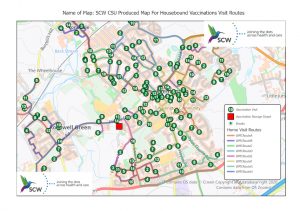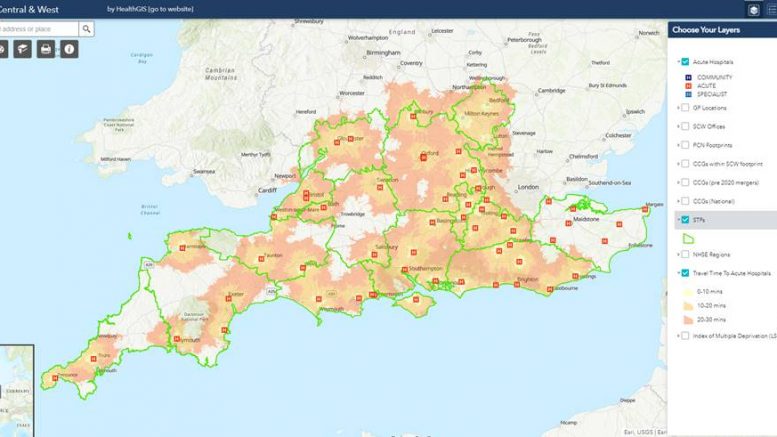New geospatial mapping techniques have been used to create optimised routes for GPs and nurses in Somerset, so they can give Covid-19 vaccinations to housebound patients more efficiently. Trevor Foster, Associate Director, Geographic Intelligence and Mapping Services, NHS South, Central and West CSU, explains how it was achieved.
The Challenge
We all know that vaccinations are the key to getting through the COVID-19 crisis. But how do you make sure housebound patients receive their vaccines in the most efficient way? PCNs in Somerset pondered this question as they began to rapidly roll out their COVID-19 vaccination programme.
The approach for this first round of vaccinations turned out to be quite hectic. Allison Nation, Associate Director of Digital Strategy for Somerset CCG, was soon approached by one of her PCN GPs asking if there was some clever technology SCW CSU have, such as digital mapping, which could help support a more efficient method. And this was how our GIS (Geographic Information Systems) team become involved – geospatial analysis being at the heart of what we do. The need for a new approach quickly escalated, as a second PCN in Somerset also wanted the solution urgently for their 200 housebound patients.
The Solution
In planning how vaccinators go out and see patients, there were a few parameters to consider:
- Where is the vaccine stored? Where does it need to be collected from? This is usually one central place in a PCN area
- What time of day do vaccinators start and what time do they plan to finish?
- The vaccine vial contains 11 doses and it is critical to use all doses and not waste any
- Once open, the vial contents last 6 hours. Within this time, up to 11 jabs need to be completed
Our approach involved taking all the patient addresses and planning the optimal routing to cover as many patients as possible, in as few journeys, so they could fit within the time window for each vial.
This was achieved by modelling a structured data set, which contains a unique patient identifier, such as NHS or EMIS system number and the full address, to pinpoint specific house locations. Using this data, the geospatial analysis creates the fewest number of trips needed over the time period. Each route is sequenced from start to finish, giving the order in which the mapping tool recommends the visits be carried out. The sophisticated modelling also builds in other relevant factors, including breaks, households with more than one patient, time taken to ring the doorbell, chat with the patient, give the jab and sit with each patient for 15 minutes recovery.
Using our Esri GIS software, we were able to react extremely quickly to the request and build the original model and procedures in less than 2 weeks, from the initial contact on 22 January, to launching a full solution to the PCN on 4 February. Esri GIS Network Analyst routing tools are very configurable and were ideal for solving the vaccination logistical challenges presented. We were able to model the specified requirements quickly and provide clients with optimised routes in a relatively short timeframe.
Journey data is supplied in a spreadsheet, with a map providing a visualisation of the routes for the vaccinators, with each location shown as a dot on the map. These are then clustered into groupings to match the dosage and time requirement. Routes can include patients from multiple practices within the PCN, with GPs vaccinating each other’s patients to increase efficiency even further.

Image | SCW
The Benefits
Critically, the solution minimises wastage of the vaccine and PCNs can plan thoroughly and communicate better with patients in advance. Patients in each cluster will know when to expect their visits and vaccinators can call patients to confirm an accurate time. The model also builds in contingency time for unexplained delays, which maximises the vaccination programme success rate.
The routing solution is saving the PCNs time and money, as previously, the PCNs planning was not often optimised and journeys were quite chaotic. This resulted in increased journey times so the programme was not only taking longer but fewer doses were being given each day. This increased the number of days needed for vaccinations and consequently the cost of delivering the programme.
Using its expertise to model the data and interpret requirements into logical solutions, the GIS team was able to deliver the initial development in less than 2 weeks. With development of all the procedures now complete and any pitfalls already resolved, the solution is now ready to be set-up for new PCNs within only 1-2 days, providing that good patient data is supplied (templates are provided).
Patient confidentiality is protected as no patient identifiable data is transferred from practices. Patient name and contact details are matched only within the practice when they follow-up to make appointments. The solution has been developed using proprietary Esri commercial software which SCW CSU owns, so the system is secure. The data used is the most accurate available too. As an Ordnance Survey (OS) partner, SCW has access to specific OS products to deliver this accuracy. As an approved data processor for NHS England national patient data sets, we ensure the most up-to-date details are used, further increasing accuracy.
Overall, the new mapping solution can be used to improve vaccination planning for the remaining first jab patients who are housebound and also to plan the second round of jabs, enabling these to be managed more efficiently.
Allison Nation, Associate Director, Digital Strategy, Somerset CCG commented:“A well organised, professional and highly responsive team, who clearly wanted to help our local practices as part of the PCN COVID Vaccination programme, in planning large groups of vaccinations for housebound patients. The SCW GIS team engaged to understand the need and context, and were quick to identify the key questions, dataset, work through relevant information governance and technical details. A great outcome in a high-paced programme!”
Dr Sally di Mambro, GP principle/partner at Wellington Medical Centre/Taunton Deane West PCN, said: “The SCW GIS team assisted at short notice in allocating our 220-ish housebound patient groups into ordered geographical groups. With three practices and crossing over lists/geographical areas, it is a way in which the housebound vaccinating can be organised without the need for agonising lists and cross referencing between practices. They have risen to our last-minute demands with efficiency and professionalism. In short, the exercise has been time well spent.”
About the Author:
Trevor Foster, Associate Director of Geographic Intelligence and Mapping Services, SCW CSU, has 40 years’ experience as a cartographer and GIS specialist. His career started as a Military Survey cartographer in The Royal Engineers, where he was involved in all aspects of cartographic map production, including mapping The Falkland Islands in 1982 and management of senior staff operational charts for the Gulf War in 1990. Trevor now leads a team of GIS Analysts who provide mapping and spatial analysis services to Clinical Commissioning Groups and Integrated Care Systems, NHS England, Hospital Trusts and General Practices.
Over the last three years, Trevor’s team has doubled in size from seven to 14 GIS specialists, due to the ever increasing demand on its recognised expertise in the use of GIS technology within healthcare. To compliment this growth, the team has recently migrated onto the Esri GIS software platform, enabling the continued growth of the division and the development of innovative solutions and services. The GIS team is already finding its time-to-market for client solutions is being reduced as a result.
About NHS South, Central and West CSU
Based in the south of England, SCW’s team of 1,300 skilled professionals provides expert support for more than 80 NHS and non-NHS customers – nationally, regionally and locally. We are proud to be making a difference for 14 million people across an area of 15,600 square miles. As a delivery partner for 13 STPs (Sustainability and Transformation Partnerships), we have been at the heart of emerging Integrated Care Systems (ICSs) and the increasing adoption of population health management approaches.
Website: https://www.scwcsu.nhs.uk/about-us/
About Esri UK
Esri is the global market leader in geographic information system (GIS) software.
UK healthcare customers include Public Health Scotland, NHS South, Central and West Commissioning Support Unit, Welsh Ambulance Service and UCL Virus Watch. Examples of Esri Covid-19 dashboards around the world include Johns Hopkins University and WHO Europe. https://www.esriuk.com/en-gb/industries/health/overview





